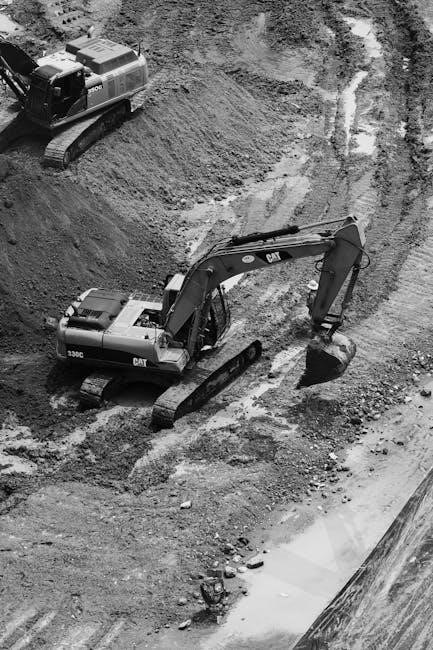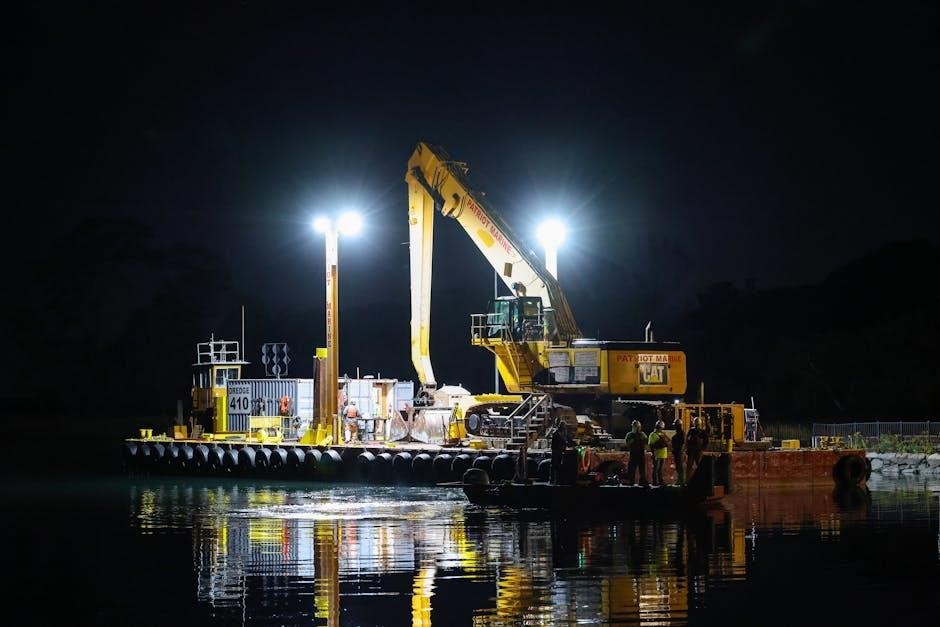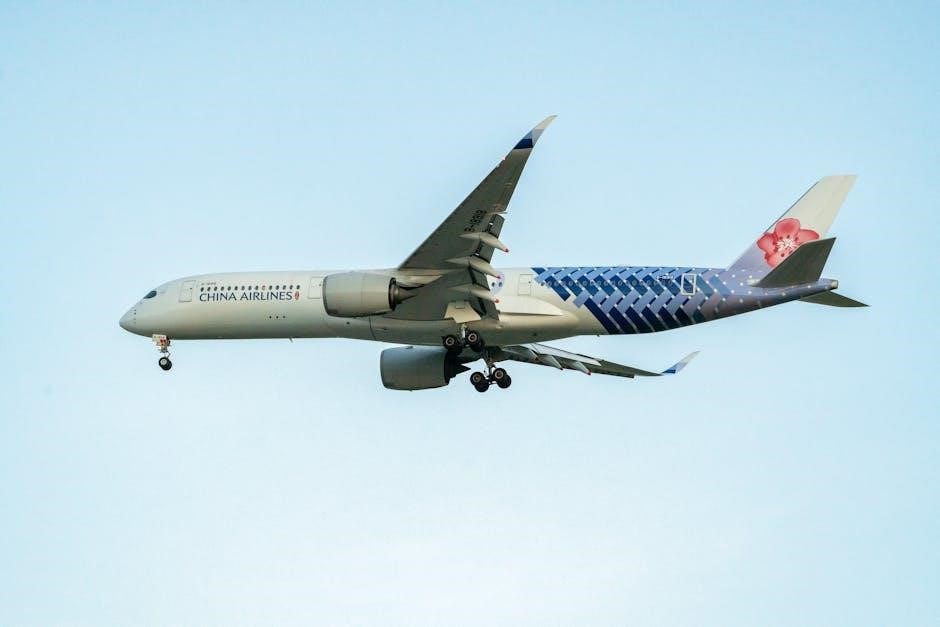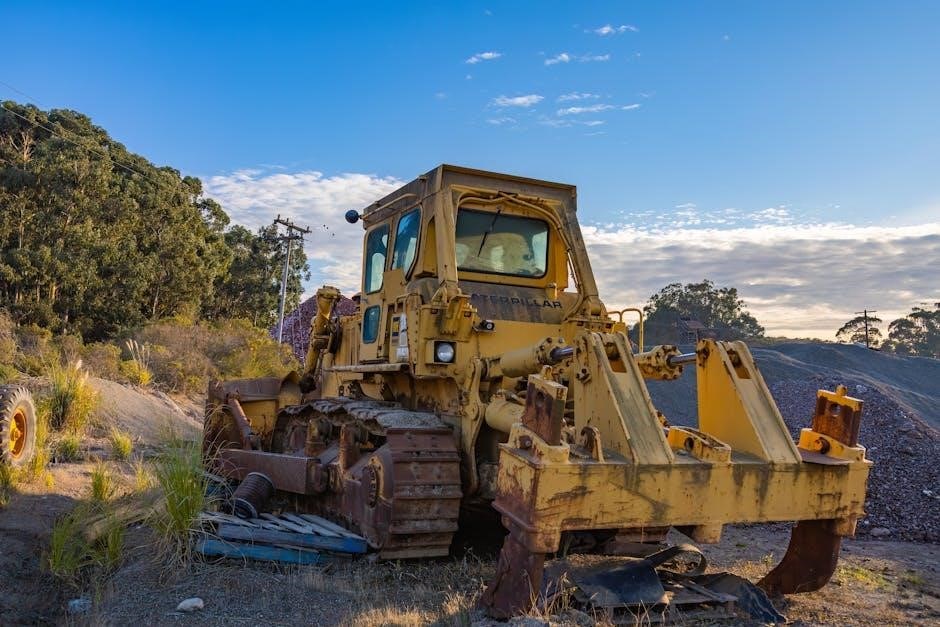The Caterpillar 3406 engine is a renowned diesel powerhouse, known for reliability and durability, widely used in marine, industrial, and heavy-duty applications. Detailed specifications are available in official Caterpillar PDF manuals, accessible via their website or authorized dealers, making it a crucial resource for engineers and technicians seeking comprehensive technical data.
1.1 Overview of the Caterpillar 3406 Engine
The Caterpillar 3406 engine is a high-performance diesel engine renowned for its reliability, durability, and versatility across various industrial applications. It is widely used in marine, heavy-duty trucks, and construction equipment due to its robust design and efficient operation. The engine features a 6-cylinder in-line configuration with a displacement of 14.6 liters, offering impressive power output and torque. Its specifications, including bore, stroke, compression ratio, and firing order, are meticulously detailed in official Caterpillar PDF manuals. These documents are essential for engineers, technicians, and operators seeking comprehensive technical data to optimize performance and maintenance. The 3406 engine’s popularity stems from its proven track record in demanding environments, making it a cornerstone of industrial power solutions.
1.2 Importance of Engine Specifications
Engine specifications are critical for understanding the capabilities, limitations, and operational requirements of the Caterpillar 3406 engine. These details ensure proper installation, maintenance, and performance optimization. Specifications guide technicians in troubleshooting, repairs, and selecting compatible parts. They also help operators understand fuel efficiency, power output, and torque ratings, which are essential for maximizing productivity. Additionally, specs aid in compliance with safety standards and environmental regulations. For users, having accurate and up-to-date specifications prevents costly errors and extends engine lifespan. The Caterpillar 3406 engine specifications PDF provides a comprehensive reference, ensuring reliability and efficiency in industrial, marine, and heavy-duty applications. This document is indispensable for engineers, mechanics, and operators seeking precise technical data.

Engine Overview and History
The Caterpillar 3406 engine is a durable diesel engine, widely recognized for its reliability and performance. Introduced in the late 20th century, it has served various industries effectively over the years.
2.1 Development and Evolution of the 3406 Engine
The Caterpillar 3406 engine was first introduced in the early 1970s, marking a significant milestone in diesel engine technology. Designed for heavy-duty applications, it was built on Caterpillar’s legacy of durability and performance. Over the years, the engine underwent several design improvements, including enhancements to fuel injection systems, combustion chamber design, and emissions control. These updates aimed to increase power output, reduce fuel consumption, and meet stricter environmental regulations. The 3406 engine became renowned for its reliability and versatility, making it a preferred choice for marine, industrial, and heavy machinery sectors. Its evolution reflects Caterpillar’s commitment to innovation and meeting the demands of a changing market.
2.2 Key Design Features of the 3406 Engine
The Caterpillar 3406 engine is renowned for its robust design and advanced engineering. It features a V-8 cylinder configuration, offering a balance between power and compactness. The engine incorporates a direct fuel injection system, which enhances fuel efficiency and power output. Its cooling system is designed for optimal thermal management, ensuring reliability under heavy loads. The 3406 also boasts a turbocharged design, increasing airflow and combustion efficiency. Constructed with high-strength materials, the engine is built to withstand harsh operating conditions. Additional features include an overhead camshaft, hydraulic lash adjusters, and replaceable wet cylinder liners, which contribute to its durability and ease of maintenance. These design elements make the 3406 engine a reliable choice for demanding applications.
Technical Specifications of the Caterpillar 3406 Engine
The 3406 engine features a displacement of 14.6 liters, 8 cylinders, and a compression ratio of 16:1, delivering high torque and efficiency for heavy-duty applications.
3.1 Displacement and Cylinders
The Caterpillar 3406 engine features a displacement of 14.6 liters, making it a robust powerplant for heavy-duty applications. It is configured as an 8-cylinder, V-8 engine, providing a balance of power and efficiency. The V-8 design allows for a compact footprint while delivering high torque and horsepower. This configuration is well-suited for industrial and marine applications, where space and performance are critical. The engine’s displacement and cylinder arrangement contribute to its reliability and durability, making it a popular choice for demanding environments. These specifications ensure the 3406 engine meets the needs of various industries requiring consistent and powerful performance.
3.2 Compression Ratio and Torque Specifications
The Caterpillar 3406 engine operates with a compression ratio of 16:1, which enhances fuel efficiency and combustion performance. It delivers a maximum torque output of 1,440 lb-ft at 1,400 RPM, ensuring strong pulling power for heavy-duty tasks. The engine’s torque curve is designed to provide consistent performance across a wide RPM range, making it suitable for both industrial and marine applications. These specifications highlight the engine’s ability to handle demanding workloads while maintaining reliability and durability. The combination of high compression ratio and impressive torque ensures optimal performance in various operating conditions, solidifying the 3406’s reputation as a versatile and powerful engine.
3.3 Firing Order and Rotation Direction
The Caterpillar 3406 engine features a firing order of 1-5-3-6-4-2, which is critical for maintaining proper engine balance and performance. The engine rotates counterclockwise when viewed from the front, a standard configuration for most Caterpillar engines. This rotation direction ensures compatibility with various applications, including marine and industrial equipment. Proper alignment with drivetrain components is essential to avoid mechanical stress and ensure smooth operation. Adhering to the specified firing order and rotation direction is vital for maintaining engine efficiency, reducing wear, and preventing potential damage. These specifications are detailed in the Caterpillar 3406 engine manual and service guides for reference and maintenance purposes.
3.4 Bore, Stroke, and Piston Dimensions
The Caterpillar 3406 engine features a bore of 5.5 inches and a stroke of 6.25 inches, contributing to its robust design and performance capabilities. The pistons are engineered to withstand high compression ratios and the rigors of heavy-duty operation. Specific piston dimensions ensure proper fitment within the cylinders, maintaining optimal combustion efficiency. These measurements are critical for maintaining engine balance and minimizing wear. Accurate bore and stroke specifications are essential for rebuilding or overhauling the engine, ensuring precise tolerances are maintained. Proper piston alignment and sizing are vital for achieving the engine’s designed power output and reliability, making these dimensions fundamental to the 3406’s overall performance and longevity.
Performance Parameters
The Caterpillar 3406 engine’s performance parameters are critical for its operational efficiency, durability, and reliability in various applications, delivering consistent power output and meeting specific operational demands, ensuring optimal performance across different industrial and marine environments.
4.1 Horsepower and Torque Output
The Caterpillar 3406 engine is renowned for its robust horsepower and torque output, delivering between 250 to 400 horsepower depending on the specific configuration and application. Torque output typically ranges from 660 to 1,200 lb-ft at low RPM, ensuring excellent performance in demanding environments. This engine’s power delivery is smooth and consistent, making it highly reliable for both marine and industrial applications. Its impressive torque-to-horsepower ratio allows for efficient operation under heavy loads, while maintaining fuel efficiency. The 3406’s ability to sustain high performance over extended periods has made it a preferred choice in heavy-duty and construction equipment, showcasing Caterpillar’s commitment to power and durability.
4.2 Engine Speed and RPM Range
The Caterpillar 3406 engine operates within a versatile RPM range, typically between 1,200 and 2,100 revolutions per minute; This range ensures optimal performance across various applications, from marine propulsion to industrial machinery. The engine’s design allows it to maintain high efficiency and reliability at different speed settings, making it adaptable to diverse operational demands. Whether under heavy load or idle, the 3406 engine delivers consistent power delivery. Its RPM range is carefully calibrated to balance fuel efficiency and power output, ensuring minimal wear and tear over extended use. This flexibility in engine speed contributes to its popularity in both marine and industrial sectors.
4.3 Fuel Efficiency and Consumption Rates
The Caterpillar 3406 engine is known for its robust fuel efficiency, making it a reliable choice for demanding applications. With a typical fuel consumption rate of approximately 10-15 gallons per hour at full load, the engine balances power delivery with economical operation. Its advanced combustion technology minimizes fuel waste, ensuring optimal energy conversion. Factors such as load conditions, engine speed, and maintenance practices significantly influence fuel efficiency. Regular servicing and adherence to recommended oil and filter specifications further enhance its performance. The 3406 engine’s fuel efficiency contributes to lower operational costs, making it a preferred option for marine, industrial, and construction applications where fuel economy is critical.

Applications of the Caterpillar 3406 Engine
The Caterpillar 3406 engine is widely used in marine vessels, industrial machinery, and heavy-duty construction equipment due to its high power output and reliability.

5.1 Marine Applications
The Caterpillar 3406 engine is widely utilized in marine applications due to its robust design, reliability, and high power output. It is commonly installed in commercial vessels, fishing boats, and recreational yachts, providing dependable propulsion and auxiliary power. The engine’s compact size and lightweight construction make it ideal for marine environments where space and weight are critical factors. Its high torque at low RPM ensures smooth operation in varying sea conditions. Additionally, the 3406 engine meets marine emissions regulations, making it an environmentally friendly choice for shipowners. Regular maintenance and adherence to Caterpillar’s service intervals ensure optimal performance and longevity in marine settings.
5.2 Industrial Applications
The Caterpillar 3406 engine is extensively used in industrial applications, powering heavy machinery, generators, and pumps. Its durability and high torque output make it ideal for demanding environments such as mining, oil and gas extraction, and construction sites. The engine’s reliability ensures continuous operation in critical industrial processes, minimizing downtime. Additionally, it is often employed in large-scale manufacturing plants to drive compressors, conveyor systems, and other heavy-duty equipment. The 3406 engine’s fuel efficiency and low emissions also make it suitable for environmentally sensitive industrial operations. Regular maintenance, as outlined in the specifications, ensures optimal performance and extends the engine’s service life in industrial settings;
5;3 Heavy-Duty and Construction Equipment
The Caterpillar 3406 engine is widely used in heavy-duty and construction equipment, including bulldozers, excavators, and cranes. Its high horsepower and torque output make it ideal for powering machinery in challenging environments. The engine’s robust design ensures reliability in extreme conditions, such as high temperatures and heavy loads. It is commonly found in wheel loaders, dump trucks, and road rollers, where consistent performance is critical. The 3406 engine’s fuel efficiency and durability also make it a preferred choice for construction sites requiring prolonged operation. Its compact size and versatility allow it to be integrated into a variety of heavy-duty applications, ensuring optimal productivity and minimal downtime.

Maintenance and Service Guidelines

Regular maintenance is crucial to ensure the Caterpillar 3406 engine operates efficiently and lasts longer. Follow recommended service intervals and guidelines to prevent breakdowns and extend lifespan.
6.1 Routine Maintenance Requirements
The Caterpillar 3406 engine requires consistent routine maintenance to ensure optimal performance and longevity. Regular checks include inspecting belts, hoses, and coolant levels to prevent overheating. Air filters should be cleaned or replaced as needed to maintain proper airflow. Hydraulic and fuel systems must be monitored for leaks or blockages. Additionally, the exhaust system should be checked for damage or corrosion. Always refer to the owner’s manual for specific intervals and procedures. Proper lubrication of moving parts is essential to reduce wear and tear. By adhering to these maintenance routines, operators can minimize downtime and ensure the engine operates within specified parameters.

6.2 Oil and Filter Specifications
The Caterpillar 3406 engine requires specific oil and filter specifications to ensure proper lubrication and filtration. The recommended oil grade is API CJ-4 or SN, with a viscosity of 15W-40 for most operating conditions. In colder climates, 10W-30 may be used. The engine has a total oil capacity of approximately 42 quarts, depending on the application. Genuine Caterpillar oil filters are recommended for optimal performance. Fuel filters should also be replaced regularly, with the primary fuel filter/water separator and secondary fuel filter requiring attention. Oil and fuel filters should be changed every 500 hours of operation, or as specified in the maintenance manual. Always consult the official Caterpillar 3406 engine specifications for precise details.
6.3 Recommended Service Intervals
The Caterpillar 3406 engine requires regular maintenance to ensure optimal performance and longevity. Service intervals are designed to prevent wear and tear. Oil and filters should be changed every 500 hours of operation, while fuel filters are recommended to be replaced every 750 hours. Coolant should be tested every 1,000 hours and replaced every 2,000 hours. Air filters should be inspected every 500 hours and replaced as needed, especially in dusty environments. Valve lash adjustments are due every 1,500 hours, and fuel injectors should be serviced every 3,000 hours. Adhering to these intervals ensures reliability and reduces the risk of unexpected downtime. Always refer to the official Caterpillar 3406 engine specifications for detailed guidelines.

Troubleshooting Common Issues
Troubleshooting common issues involves identifying symptoms, checking diagnostic codes, and performing necessary repairs or adjustments to maintain optimal engine performance and reliability.
7.1 Identification of Serial Numbers
The Caterpillar 3406 engine’s serial number is crucial for maintenance, parts ordering, and compliance. It is typically located on the engine block or a dedicated label. The serial number format is alphanumeric, consisting of letters and digits that denote the engine model, production year, and manufacturing plant. For the 3406, the serial number is essential for accessing specific service manuals and ensuring compatibility with replacement parts. Users can find detailed guidance on locating and interpreting the serial number in the official Caterpillar 3406 engine specifications PDF. Accurate identification helps prevent mismatches and ensures adherence to warranty and regulatory requirements. Always cross-reference the serial number with official documentation for accuracy.
7.2 Common Engine Problems and Solutions
The Caterpillar 3406 engine, like any heavy-duty engine, can experience issues such as low compression, overheating, or fuel system malfunctions. Low compression in cylinders often results from worn piston rings or head gasket leaks, requiring inspection and replacement. Overheating can stem from a faulty thermostat, blocked coolant passages, or a malfunctioning cooling fan, necessitating thorough inspection and repairs. Fuel system issues, such as clogged injectors or faulty fuel pumps, can cause poor performance and require cleaning or replacement. Regular maintenance, as outlined in the Caterpillar 3406 engine specifications PDF, helps prevent these problems. Addressing issues promptly ensures optimal performance and extends engine lifespan.
7.3 Diagnostic Techniques and Tools
Diagnosing issues with the Caterpillar 3406 engine requires specialized tools and techniques. The Cat ET (Electronic Technician) software is essential for reading fault codes, monitoring performance, and troubleshooting electronic systems. A digital multimeter is used to test electrical circuits, while a compression tester helps identify low compression issues in cylinders. Pressure gauges are employed to check fuel system performance and coolant system integrity. The Caterpillar 3406 engine specifications PDF provides detailed procedures for using these tools effectively. Regular use of diagnostic tools ensures early detection of potential problems, minimizing downtime and extending engine life. Proper training and adherence to safety protocols are critical when performing diagnostics.
Product Support and Availability
Caterpillar offers extensive global support with a vast dealer network, genuine parts availability, and comprehensive service agreements. Warranty options and technical resources ensure reliable engine operation and maintenance.
8.1 Global Dealer Network and Parts Availability
The Caterpillar 3406 engine benefits from a worldwide network of authorized dealers, ensuring easy access to genuine parts and expert service. With strategically located distributors, customers can quickly obtain components, reducing downtime. Cat’s extensive parts inventory includes everything from filters to major engine components, all designed to meet OEM standards. This global support system ensures that 3406 engine owners can maintain peak performance and reliability, no matter the location. Additionally, online resources and 24/7 customer support further enhance accessibility, making it easier to find and purchase parts. This robust network is a key factor in the engine’s reputation for durability and long-term value.

8.2 Warranty and Service Agreements

Caterpillar offers comprehensive warranty and service agreements for the 3406 engine, ensuring long-term reliability and customer satisfaction. The standard warranty covers parts and labor for a specified period or operating hours, protecting against defects in materials and workmanship. Extended service agreements are also available, providing additional coverage beyond the initial warranty. These agreements include regular maintenance, repairs, and access to genuine parts, minimizing unexpected costs. Cat’s warranty and service programs are designed to maximize uptime and performance, aligning with the engine’s reputation for durability. Customers can rely on these programs to maintain their 3406 engine’s optimal condition, ensuring uninterrupted operation in demanding applications.
8.3 Technical Assistance and Resources
Caterpillar provides extensive technical assistance and resources to support the 3406 engine, ensuring optimal performance and troubleshooting. Owners and technicians can access detailed service manuals, parts catalogs, and diagnostic guides through Cat’s official website or authorized dealers; The Cat Electronic Technician (Cat ET) software is a key resource for real-time diagnostics, enabling precise issue identification and repair. Additionally, Caterpillar offers online training programs and webinars to enhance technical expertise. A global network of dealers and support centers ensures rapid assistance, while 24/7 customer service provides immediate help for critical issues. These resources empower users to maintain and repair the 3406 engine efficiently, maximizing its lifespan and productivity.
